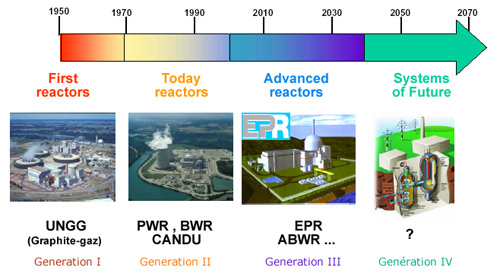Powering the future with the nuclear option : An abundant source of energy without CO2
Does nuclear energy have a future? The potential depletion of the Earth’s gas and petrol reserves, combined with global warming caused by the greenhouse effect, may force humanity to find other sources of energy. For nuclear energy to take the place of fossil fuels, however, new types of reactor will need to be developed.
The ancestors of today’s reactors were first conceived as part of President Eisenhower’s ‘Atoms for Peace’ programme in 1953. The techniques used then are still in use today; techniques which remain effective but need to be improved for nuclear power plants to take their place on the global stage. Modern ‘slow neutron’ reactors, for instance, only use a small fraction of the energy contained in the uranium fuel. This is because they rely on the fission of the very rare uranium 235 nuclei, which make up less than 0.7% of the total nuclei present. The other nuclei can also produce energy, provided that a neutron capture will cause them to transmute into plutonium 239 – an interesting method that is marginally exploited in slow neutron reactors.

Reactor generations:
Commercial reactors such as boiling water, pressurized water or CANDU reactors are referred to as ‘second generation’ reactors, where ‘first generation’ reactors are those developed in the 1950’s and ‘60’s to equip submarines and aircraft carriers. The 2nd generation is currently giving way to an advanced ‘third generation’ built along lines similar to the pressurized water reactors. Though this transition has not yet been completed, there is need to go to ‘fourth generation’ reactors, which will be more fuel efficient and environmentally friendly, and are foreseen to be ready for use in thirty years.
© IN2P3
Among the six proposals for what are known as ‘fourth generation’ concepts, there are currently three proposals for reactors capable of harnessing the energy produced when uranium 238 transforms into plutonium 239. This procedure, the creation of one new fissile nucleus for every one destroyed, amounts to a regeneration of the fuel and can only be achieved from uranium nuclei with « fast neutrons« .
A fourth suggestion involves a thorium-based reactor, and atransformation from thorium 232 fuel to the fissile nucleus uranium 233. The main advantage of this method is that slow neutrons will be just as effective as fast neutrons, allowing the reactor to make substantial energy savings. The last two concepts aim at a much improved use of the uranium fuel but not to full regeneration.
And what about the waste? The adoption of nuclear reactors as a major energy source depends on a reduction of the radioactive waste produced. The focus is now on cutting down on those radioactive isotopes with longer half-lives; a group which includes heavy nuclei such as plutonium and the minor actinides.
In the reactors of the future, forced reprocessing and recycling of the fuel should result in the consumption of virtually all the heavy nuclei present. Possible specialised reactors, such as hybrid reactors, may be devoted to the destruction of radioactive isotopes whose long lifetimes are an issue.
The inevitable growth in our demand for energy gives added importance to the safety considerations surrounding nuclear reactors. The possible need to build these facilities in less-developed regions of the world is in particular a potential source of risk, as high technical competence is required for their maintenance.
One of the most worrying risks associated with the spreading of nuclear technology, however, is the global dissemination of fissile materials. Such a nuclear proliferation must be avoided at all costs and the new concepts of reactors should be proliferation resistant.
Articles on the subject « Future Reactors »
Generation III Reactors
The reactors of tomorrow before those of after tomorrow Designed in the 1990s, third-generation r[...]
EPR Reactors
EPR: a third generation pressurized water reactor Third generation reactors are reactors intended[...]
The nuclear option ?
Energy challenge : meeting energy demands of the Future The emergence of huge future needs by de[...]
Generation IV
Towards a fourth generation of reactors To meet the formidable challenges of sustainable developm[...]
Molten Salt Reactors
Promising reactors … but in a remote future Molten Salt Reactors are very different in desi[...]